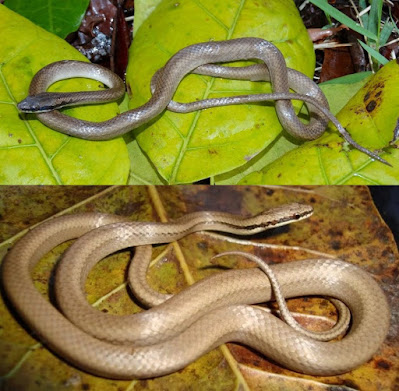 |
| Caaeteboia gaeli Montingelli, Barbo, Filho, Santana, França, Gobbi & Zaher, 2020 |
ABSTRACT
Caaeteboia is a rare and elusive monotypic genus of Neotropical snake, being one of the least known dipsadids of the Brazilian Atlantic Forest. Here, we assess the morphological and genetic diversity of this genus, comparing these results with several other genera of Xenodontinae. Our combined results revealed the presence of an unknown species from the northeastern portion of the Atlantic Forest. The new species is distributed throughout the enclaves of coastal open forests mixed with savanna-like habitat, locally known as “Floresta de Tabuleiro”, and submontane ombrophilous forests in the Brazilian states of Paraíba and Pernambuco. This new species is easily distinguished from C. amarali by its lower number of dorsal, ventral, and subcaudal scales, and a remarkable dark lateral stripe from the nostril up to the anterior third of the body. The new species extends the distribution of the genus in approximately 700 kilometers northwards, reinforcing the importance of the conservation of small remnants of Atlantic Forest in northeastern Brazil, which still harbor high levels of endemicity and diversity.
Key words: Caaeteboia; Atlantic Forest; Taxonomy; Xenodontinae; New Species.
Caaeteboia gaeli sp. nov.
Caaeteboia sp. — Pereira-Filho et al., 2017: 170.
Serpentes da Paraíba: diversidade e conservação.
Diagnosis: Caaeteboia gaeli sp. nov. is diagnosed by a slender
and small body; rounded pupil; eight supralabials
(fourth and fifth contacting the orbit); nine infralabials (first to fourth contacting chinshields); loreal
absent (fused with prefrontals); a preocular single
and wide; two postoculars; temporals 2+2/1+2, or
2+1/2+1; dorsals 15/15/15; at least 158 ventrals,
92–106 paired subcaudals; anal plate divided;
continuous dark-brown lateral stripe, bordered in
black, extending from nasal, to the anterior portion
of body, on rows of dorsals three and four, starting
to fade after the10–15th ventrals, weakening towards
the end of body; posterior to parietals, “V” shaped
dark-mark, extending backwards and forming a
weak vertebral stripe fading posteriorly; hemipenial
lobes almost completely covered with calyces and
naked area restricted to the small and poorly marked
lobular crotch, on the asulcate side; medial edges of
lobes poorly demarcated and bordered with spines;
lobular crest poorly developed, bearing small spines
on its edge (Fig. 6A).
Etymology: The specific name honours Gael Hingst Zaher. GGM, FEB, GAPF, GGS, FGRF and FGG dedicate this species to the beloved son of the senior author, who sadly left us prematurely in March, 2020.
Giovanna Gondim Montingelli, Fausto Erritto Barbo, Gentil Alves Pereira Filho, Gindomar Gomes Santana, Frederico Gustavo Rodrigues França, Felipe Gobbi Grazziotin and Hussam Zaher. 2020.
A Second New Species for the Rare Dipsadid Genus Caaeteboia Zaher et al., 2009 (Serpentes: Dipsadidae) from the Atlantic Forest of northeastern Brazil. Cuad. herpetol. 34 (2): 219-230. DOI: 10.31017/CdH.2020.(2020-003)
Pesquisadores descobrem nova espécie de cobra endêmica da Mata Atlântica
Resumo: Caaeteboia é um gênero de serpente raro e monotípico da região Neotropical, sendo um dos dipsadídeos menos conhecidos da Foresta Atlântica brasileira. Nesse trabalho, avaliamos a diversidade morfológica e genética desse gênero, comparando-o com outros gêneros de Xenodontinae. Nossos resultados combinados revelaram a presença de uma espécie desconhecida da porção nordeste da Floresta Atlântica. A nova espécie se distribui ao longo dos enclaves de florestas abertas costeiras misturadas com habitats savânicos, conhecidos localmente por “Florestas de Tabuleiro”, e florestas ombrófilas submontanas nos estados da Paraíba e de Pernambuco. Essa nova espécie é distinguida de C. amarali pelo menor número de escamas dorsais, ventrais e subcaudais, e por uma evidente linha escura lateral desde o focinho até o terço anterior do corpo. A nova espécie amplia a distribuição do gênero para aproximadamente 700 quilômetros ao norte, e reforça a importância da conservação dos pequenos remanescentes de Floresta Atlântica no nordeste do Brasil, os quais ainda abrigam altos níveis de endemismo e diversidade.
Palabras clave: Caaeteboia; Floresta Atlântica; Taxonomia; Xenodontinae; Nova Espécie;





